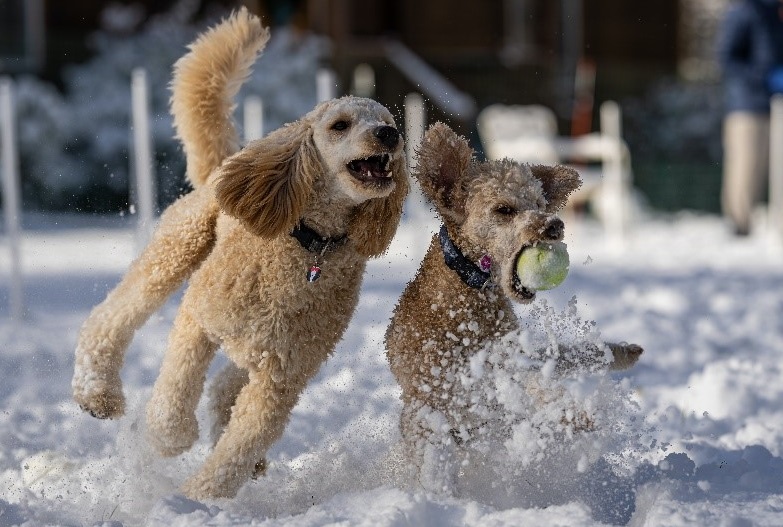Why Are My Dogs Ears Cold?
Do you notice your dog’s ears are cold or appear to be cooler in temperature than the rest of their body? In most cases, there is a benign or harmless reason, which may be due to a sudden change in room temperature or a cold draft, which can cause a chill. A dog’s ears are typically thin and are often the first part of their body to drop in temperature when the weather shifts from warm to cold, or they’ve just come in from outside, playing in the snow.
While most dogs’ ears can get cold now and then, which shouldn’t pose any health risks, there are some instances where cold ears can be a sign of a more severe condition, such as an ear canal infection, lack of blood flow, or frostbite, it’s essential to monitor your pet’s ears to ensure there are no issues with your dog or pup’s ears. Several reasons can cause your dog’s ears to get cold, which should be considered to ensure no serious problems or medical conditions.
Your Dog’s Size and Breed
Many small or medium-sized dogs, such as Cocker Spaniels, Terriers, or Poodles, tend to experience changes in their body temperature, which quickly cools their ears. It’s not uncommon to notice a cold nose or paws, especially if a dog spends time outdoors in the winter months, even for a short time.
Small and medium dog breeds with shorter fur, especially older dogs or underweight pets, can feel cold quickly, which can be remedied with warm clothing or a blanket.
Issues With Blood Flow, Illness, and Circulation Disorders
If a dog’s ears are consistently cold, even in hot or warmer climates, they may have poor circulation, a symptom of a severe medical condition. It’s crucial to rule out any dog ear infection or similar issues, such as ear mites, ear canal issues, or a chronic ear infection that can make your dog’s ears cold.
Dogs that reside in a cold climate, especially below-freezing temperatures during the winter months, should be observed for signs of hypothermia or frostbite, which can occur when there’s extreme cold weather or prolonged exposure outside.
While some dog breeds are accustomed to a low temperature, such as the Alaskan Malamute or a Siberian Husky, it’s essential to monitor their health and visit a veterinarian regularly to ensure there are no severe health conditions, such as heart disease and circulatory problems, such as blood clots or other factors that can restrict blood flow.
In many cases, a change in diet and proper medication, as prescribed by a veterinarian, can help prevent serious circulation issues and keep your pet healthy.
Hypothermia and Frostbite
While hypothermia and frostbite are not likely to be a high risk if you live in a relatively warm region, it’s essential to notice a sudden drop in temperature or factors that can significantly reduce your dog’s temperature. If your dog’s skin around their ears or other body parts changes to grey, blue, or becomes swollen, contact an emergency veterinarian immediately, as this may be frostbite.
Hypothermia occurs when your dog’s body temperature drops below 99 degrees Fahrenheit, which is life-threatening and requires urgent medical care. In this situation, a pup’s cold ears are accompanied by shivering, cold paws, and overall discomfort.
Small dogs or puppies that spend a lot of time in the cold are at greater risk, and so are dogs not adapted to colder climates. If a low temperature causes a quick change in a dog’s body, including their ears, it’s best to accommodate them as best as possible with a warm sweater, boots, or a blanket.
Viral Infection or Illness
Parvo is one of the most common viral illnesses that impacts a dog’s body temperature. This viral disease can be fatal, especially in puppies or older dogs. The most common symptoms are vomiting, diarrhea, dehydration, disorientation, and a loss of appetite.
While dogs’ ears will become cold, their entire body will cool quickly due to a lack of blood flow, leading to shock and more severe health risks. Since this illness, like kennel cough, is highly contagious, it’s important to note any symptoms and seek medical treatment from a veterinarian.
Tips for Keeping Your Dog Safe
While cold ears are often not a cause for concern, it’s essential to keep a puppy safe to avoid sudden changes in body temperature, whether it’s a fever or severe coldness. Dog owners can take easy techniques and steps to ensure their pets remain safe, whether playing outdoors in the winter or monitoring their overall health to prevent and treat illness.
1. Limit Your Dog’s Exposure Outside
Keeping your dog warm during the winter season is essential, including a seasonal jacket or coat, layers of insulation, boots, and other supportive gear to keep them comfortable outdoors. It’s also essential to limit playtime or work tasks outdoors.
While winter is the most likely time when frostbite and hypothermia are at high risk, it’s not uncommon for a sudden drop in temperature to impact a dog’s body temperature in the early spring or autumn seasons. If a puppy jumps or falls into a pool of water, this can lead to a sudden change.
2. Ear Cleaning and Regular Vet Check-Ups
Ear cleaning and regular check-ups at the veterinarian are vital for pet health. This level of care is significant if you have an older dog, puppy, or pet with specific health concerns. If you notice your dog scratching or consistently pulling on their ears, this can be another reason to contact a vet to find a suitable treatment.
3. Outfit Your Dog With Gear That’s Visible
Bright colors and prints that are easy to spot outside can help spot a puppy when they run off or find themselves
4. Always Supervise Your Dog
Regular supervision is essential in keeping your dog safe and away from patches of ice, snow, or cold water, which can drastically lower body temperature. A fenced-in park or yard is ideal for keeping a puppy or dog safe and allows them to play freely without coming into contact with a dangerous substance or area where they can risk injury.
5. Provide Shelter for Dogs
A doghouse or structure should be well insulated and secure to maintain a comfortable temperature during the winter months.
6. Get Familiar With Your Dog’s Health
Dog owners must get familiar with their pets, including how often they have cold ears, shiver, or react in various situations. These characteristics can be harmless or signs of a more serious issue, which can be reviewed and confirmed with a veterinarian.
Final Thoughts
It’s not uncommon for most dogs to experience cold ears, much like a healthy dog can have cold paws or shiver slightly after spending some time outside. When other symptoms or conditions accompany cold ears, this may be a sign of a more serious issue, which can be addressed with a vet. Generally, maintaining a dog’s body temperature at a healthy level is essential for keeping them well and comfortable.

